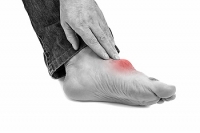Bunions are a particularly painful type of foot condition that form on the side of the feet. If you are experiencing foot pain, there are a few steps you can take in order to determine if a bunion is the cause of the discomfort. You may begin by examining your feet to look for a bony lump, or protrusion on the side of your big toe. Next, you’ll want to determine if your big toe is pointing, or leaning towards the rest of your toes. Lastly, you’ll want to check if the skin on the lump is hard, red or swollen. If you notice that all of the above are true to your case, it is very likely that you have a bunion. To relieve the pain of a bunion, it is recommended that you wear shoes wider than normal, ice the affected area on and off, look into wearing bunion pads to prevent further friction with your footwear, and try to keep the weight off of the affected area. Bunions are likely to worsen overtime, which is why we recommend you speak with a podiatrist for professional guidance and a suggested treatment plan.
If you are suffering from bunions, contact Dr. Kenneth Donovan of Advanced Care Foot and Ankle. Our doctor can provide the care you need to keep you pain-free and on your feet.
What Is a Bunion?
A bunion is formed of swollen tissue or an enlargement of boney growth, usually located at the base joint of the toe that connects to the foot. The swelling occurs due to the bones in the big toe shifting inward, which impacts the other toes of the foot. This causes the area around the base of the big toe to become inflamed and painful.
Why Do Bunions Form?
Genetics – Susceptibility to bunions are often hereditary
Stress on the feet – Poorly fitted and uncomfortable footwear that places stress on feet, such as heels, can worsen existing bunions
How Are Bunions Diagnosed?
Doctors often perform two tests – blood tests and x-rays – when trying to diagnose bunions, especially in the early stages of development. Blood tests help determine if the foot pain is being caused by something else, such as arthritis, while x-rays provide a clear picture of your bone structure to your doctor.
How Are Bunions Treated?
- Refrain from wearing heels or similar shoes that cause discomfort
- Select wider shoes that can provide more comfort and reduce pain
- Anti-inflammatory and pain management drugs
- Orthotics or foot inserts
- Surgery
If you have any questions, please feel free to contact one of our offices located in Warren, Livingston, and Toms River, NJ . We offer the newest diagnostic and treatment technologies for all your foot care needs.

